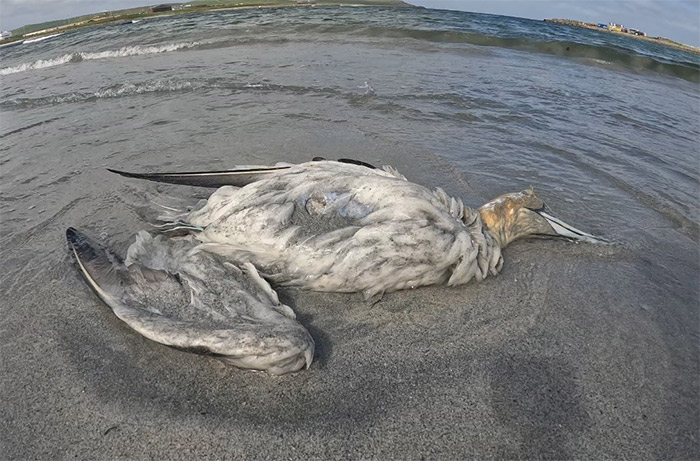**Highly Pathogenic Avian Influenza (H5N1) Outbreak in Animals: Prevention, Monitoring, and Public Health Recommendations** **April 3, 2024** In response to the ongoing outbreak of highly pathogenic avian influenza (H5N1) virus in animals, the Centers for Disease Control and Prevention (CDC) has issued interim recommendations for prevention, monitoring, and public health. **Background** Avian influenza is a type A influenza virus that primarily affects birds. The H5N1 strain of avian influenza has been detected in over 100 species of birds, including seagulls and owls. **Current Outbreak** The United States is currently experiencing an outbreak of H5N1 avian influenza in poultry. On April 2, 2024, the largest producer of fresh eggs in the country announced that it had stopped production at a Texas plant after bird flu was detected. **Human Health Risk** Although avian influenza viruses are primarily respiratory pathogens in birds, they can occasionally infect humans. Most human cases of avian influenza have resulted from direct contact with infected birds or exposure to contaminated environments. **Interim Recommendations** The CDC has issued the following interim recommendations to prevent, monitor, and control the spread of H5N1 avian influenza: * **Prevent contact with infected birds:** Avoid handling or coming into close contact with sick or dead birds. * **Monitor for symptoms:** Individuals who have had contact with infected birds should monitor themselves for symptoms of avian influenza, such as fever, cough, shortness of breath, and muscle aches. * **Report sick birds:** Report sick or dead birds to local wildlife authorities. * **Practice good hygiene:** Wash hands thoroughly after handling poultry or visiting areas where birds are present. * **Avoid raw poultry products:** Do not eat raw or undercooked poultry or eggs. **Public Health Response** Public health officials are closely monitoring the situation and collaborating with federal, state, and local agencies to contain the outbreak and prevent its spread to humans. **Additional Information** For more information on H5N1 avian influenza, visit the CDC website at https://www.cdc.gov/flu/avianflu/avian-influenza-h5n1.htm.
Fri 10 Feb 2023 1012 EST Four dead seals have tested positive for bird flu in Scotland as the number of cases of. A record of confirmed cases of bird flu in Scotland The season is recorded from October to September. This gannet at Troup Head has the dark eye colouration found in seabirds that have. Thousands of barnacle geese have died from avian flu. A major report into avian flu in wild birds in Scotland published today by NatureScot concludes that..
Outside the Galápagos the global bird flu panzootic has been destructive. Three bird specimens have tested positive for avian influenza H5N1 prompting urgent measures. National park authorities on the Galápagos Islands have heightened biosecurity measures to. Located at the confluence of three ocean currents the Galápagos are a melting pot of marine species. In a development that has alarmed conservation biologists the avian flu strain that has devastated. Galapagos National Park Directorate took immediate action in response to the alarming discovery. Three out of five dead birds have tested positive for avian influenza H5N1 according to the Galapagos. QUITO Sept 19 Reuters - Ecuadors Galapagos National Park PNG on Tuesday said that three birds had..
**Highly Pathogenic Avian Influenza (H5N1) Outbreak in Animals: Prevention, Monitoring, and Public Health Recommendations** **April 3, 2024** In response to the ongoing outbreak of highly pathogenic avian influenza (H5N1) virus in animals, the Centers for Disease Control and Prevention (CDC) has issued interim recommendations for prevention, monitoring, and public health. **Background** Avian influenza is a type A influenza virus that primarily affects birds. The H5N1 strain of avian influenza has been detected in over 100 species of birds, including seagulls and owls. **Current Outbreak** The United States is currently experiencing an outbreak of H5N1 avian influenza in poultry. On April 2, 2024, the largest producer of fresh eggs in the country announced that it had stopped production at a Texas plant after bird flu was detected. **Human Health Risk** Although avian influenza viruses are primarily respiratory pathogens in birds, they can occasionally infect humans. Most human cases of avian influenza have resulted from direct contact with infected birds or exposure to contaminated environments. **Interim Recommendations** The CDC has issued the following interim recommendations to prevent, monitor, and control the spread of H5N1 avian influenza: * **Prevent contact with infected birds:** Avoid handling or coming into close contact with sick or dead birds. * **Monitor for symptoms:** Individuals who have had contact with infected birds should monitor themselves for symptoms of avian influenza, such as fever, cough, shortness of breath, and muscle aches. * **Report sick birds:** Report sick or dead birds to local wildlife authorities. * **Practice good hygiene:** Wash hands thoroughly after handling poultry or visiting areas where birds are present. * **Avoid raw poultry products:** Do not eat raw or undercooked poultry or eggs. **Public Health Response** Public health officials are closely monitoring the situation and collaborating with federal, state, and local agencies to contain the outbreak and prevent its spread to humans. **Additional Information** For more information on H5N1 avian influenza, visit the CDC website at https://www.cdc.gov/flu/avianflu/avian-influenza-h5n1.htm.
Bird flu symptoms Among the difficulties with avian flu is that it can infect healthy chickens that initially show no symptoms of the disease. There are several symptoms of Avian Flu in chickens For instance birds with this disease may have swollen eyes apparent signs of. Nervous system signs most often include head and neck tremors wry neck inability to stand and abnormal tilted head positions. The most common low pathogenicity avian influenza is mostly harmless and infected chickens react with general flucold-like symptoms. In chickens HPAI signs often include respiratory gasping and digestive extreme diarrhea signs followed by rapid death..


Komentar